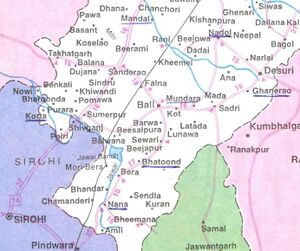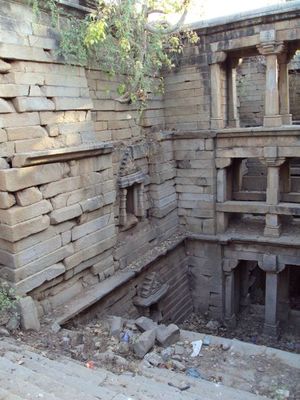Juna Khera
Juna Khera (जूनाखेड़ा) is a village in Desuri Tahsil of Pali district in Rajasthan.
Contents
Location
It is located near ancient place Nadol on the banks of Bharmal River.
Founders
History
The town is a historic place, having history with the great Hindu king Prithviraj Chauhan. Near to the town, Juna Kheda is the place which is reserved by the archeology department. Father of Prithviraj Chauhan died at this place only during fighting to the Solankis.
Migration of Chauhans : In 1197 A.D the Chauhans of Nadol migrated under Kirtipala to Jalore after attack of Qutb-ud-din Aybak. Nadol was under Chauhans up to 1291 AD. The King Kalhana and Jayat Simha fought with Muhammad Gauri. Later Jayat Simha joined hand with Parmars of Abu against Qutb-ud-din Aybak. But they were defeated. Some records tell that rulers of the Mandor also related to Chauhans of Nadol.
Excavations at Juna Khera
Excavations reveal early medieval man lived in brick and granite houses at Juna Khera:
Reference - Article by Rachna Singh, Times of India, Jaipur, May 18, 2017
The early medieval man lived in brick and granite houses that at that time had a living room, kitchen, and furnaces and used iron clamps for jointing stones of different sizes. The missing link in history just got discovered when the department of archaeology, Rajasthan, after nearly two decades excavated Juna Khera at Nadol on the banks of river Bharmal in Pali, an important early medieval settlement of Chauhan dynasty.
"Juna Khera is the only site of its kind known across the state with tremendous archaeological potential of Chauhan settlement of early medieval period during the 12th century AD. The cultural archaeology provides a very vital cultural link between the post Gupta period and late medieval period that was so far a lacuna in history. But now we know exactly how the settlements in the 9-10th century existed," said Hridesh Kumar Sharma, director, department of archaeology & museums.
A detailed survey was conducted at the site of Juna Khera for exploring the possibilities of excavation. After visiting the site that is protected under subsection 4 of section 3 of the Rajasthan Monuments and Antiquities Act 1961, it was decided by the archaeological department that the site should be re-excavated for understanding the planning of township, economy, trade, social stratification, public architecture and cultural sequence of the ancient settlement.
Though the area was occupied by the Stone Age man since lower Paleolithic period, the recent excavation revealed that Nadol was a prosperous trade centre between Jodhpur and Udaipur. "It is assumed that the site was flourishing during the 9th-10th century AD. The excavation also revealed traces of living rooms, kitchens with burning activities. Some traces of furnaces were also found during the excavations. It was found that massive undressed, semi-dressed and dressed stone blocks of marble and granite were used during the construction of buildings in the ancient time. Mud mortar was also part of their house construction and more than 20-cm mud mortar was applied on the floor of the rooms, which is interesting from the habitation point of view," said Dr Vineet Godhal, exploration and excavation officer, department of archaeology and museums.
But besides that, kiln-backed bricks were used on stone blocks. Hearths with grains were also observed during the excavation work along with a big chunk of iron piece. The pottery was of typical medieval period and mostly wheel-turned red in colour with fine fabric, mostly treated with a wash of slip. The common shapes were bowl, lid-cum bowl and lipped bowl with spouted-channels. Stone sculptural pieces, representative of early medieval art, were also discovered. The excavations confirmed the hypothesis of Nadol as quite contiguous to Mewar.
Some unfinished beads at the site also indicate that this place was used for some type of workshop related with beads. Add to the finished and unfinished beads, coins, iron objects of different types, copper rings and other objects were recovered during this season's excavation work. Seals bearing inscription in early Devanagari characters were also discovered. Coins with the inscription "La" probably referred to "Lakshamana", the founder of the Chauhan branch of Nadol, were also found.
The first excavation was done by the archaeology department at Nadol in 1996 but the recent excavations revealed direct evidences about agricultural products like wheat, black gram, mung, moth, rice, arhar and kulthi at Nadol. "The grains have been sent to Birbal Sahni Institute of Palaeobotany, Lucknow, for the study," said Hridesh Kumar Sharma.
Notable persons
External links
See also
References
Back to General History

